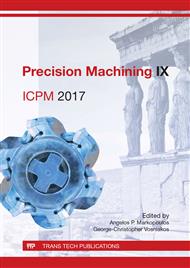[1]
M.A. El Baradie, Cutting Fluids: Part I. Characterisation, Journal of Materials Processing Technology 56 (1999) 786-797.
DOI: 10.1016/0924-0136(95)01892-1
Google Scholar
[2]
V.P. Astakhov, Ecological Machining: Near Dry Machining, in: J.P. Davim (Ed), Machining: Fundamentals and Recent Advances, Springer-Verlag, London, 2008, pp.195-223.
DOI: 10.1007/978-1-84800-213-5_7
Google Scholar
[3]
Y.M. Shashidhara, S.R. Jayaram, Vegetable Oils as a Potential Cutting Fluid - An Evolution, Tribology International 43 (2010) 1073-1081.
DOI: 10.1016/j.triboint.2009.12.065
Google Scholar
[4]
E.O. Bennett, D.L. Bennett, Occupational Airway Diseases in Metalworking Industry, Part 1: Respiratory Infections, Pneumonia, Chronic Brochitis and Emphysema, Tribology International 18(3) (1985) 169-176.
DOI: 10.1016/0301-679x(85)90137-9
Google Scholar
[5]
Occupational Safety and Health Administration, USA Department of Labor, Metalworking Fluids: Safety and Health Best Practices Manual (https: /www. osha. gov /SLTC /metalworkingfluids / metalworkingfluids_manual. html#e).
Google Scholar
[6]
M. Nouari, G. List, F. Girot, D. Coupard, Experimental Analysis and Optimisation of Tool Wear in Dry Machining of Aluminium Alloys, Wear 255 (2003) 1359-1368.
DOI: 10.1016/s0043-1648(03)00105-4
Google Scholar
[7]
M.A. Rosen, H.A. Kishawy, Sustainable Manufacturing and Design: Concepts, Practices and Needs, Sustainability 4(2) (2012) 154-174.
DOI: 10.3390/su4020154
Google Scholar
[8]
R.A. Frosh, Industrial ecology: adapting technology for a sustainable world, Environment Magazine 37(10) (1995) 17-37.
Google Scholar
[9]
A. Gungor, S.M. Gupta, Issues in environmentally conscious manufacturing and product recovery: a survey, Computers & Industrial Engineering 36 (1999) 811-853.
DOI: 10.1016/s0360-8352(99)00167-9
Google Scholar
[10]
International Technology Research Institute, World Technology Division, Department of Energy USA, Environmentally Benign Manufacturing, April (2001).
Google Scholar
[11]
M. Delmas, Stakeholders and Competitive Advantage: The case of ISO 14001, Production and Operations Management, 10(3) (2001) 343-358.
DOI: 10.1111/j.1937-5956.2001.tb00379.x
Google Scholar
[12]
http: /www. arsenal-bg. com/c/cemented-carbide-inserts-142/carbide-grades- for-turning-242.
Google Scholar
[13]
http: /www. buyitfrom. com/gnt/vortexgen. html.
Google Scholar
[14]
User's Manual for Meech Coldstream Airgun.
Google Scholar
[15]
Meech Coldstream Airgun, Technical Data Brochure for Airgun Technology.
Google Scholar
[16]
IMPAC INV 780-P datasheet.
Google Scholar
[17]
User's Manual for Innovatest TV-300.
Google Scholar
[18]
Innovatest advanced material solutions.
Google Scholar
[19]
V. Gutakovskis, G. Bunga, G. Pikurs, Cutting Tool Vibration in the Metal Cutting Process, Journal of Vibroengineering 13 (2011) 676-681.
Google Scholar
[20]
J. Malchaire, Sound Measuring Instruments, (1994).
Google Scholar
[21]
Meech, Air Technology: Reducing Energy and Noise; Both Effectively and Economically (https: /www. tom-parker. co. uk/upload/files/literature/literature_file-1064. pdf).
Google Scholar
[22]
M. Thomas, Y. Beauchamp, A.Y. Youssef, J. Manousave, Effect of Tool Vibrations on Surface Roughness during Lathe Dry Turning Process, Computers & Industrial Engineering 31 (1996) 637-644.
DOI: 10.1016/s0360-8352(96)00235-5
Google Scholar


